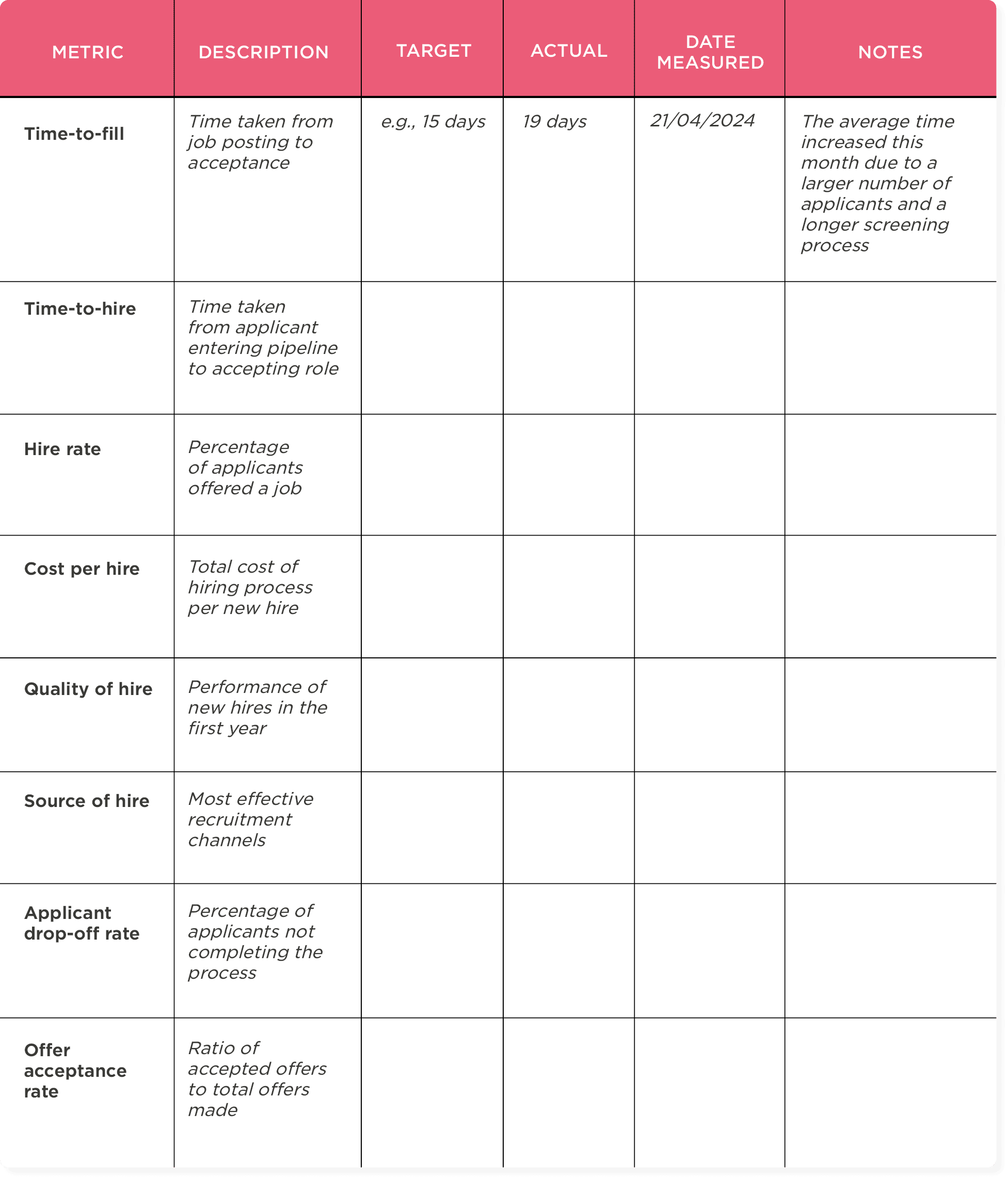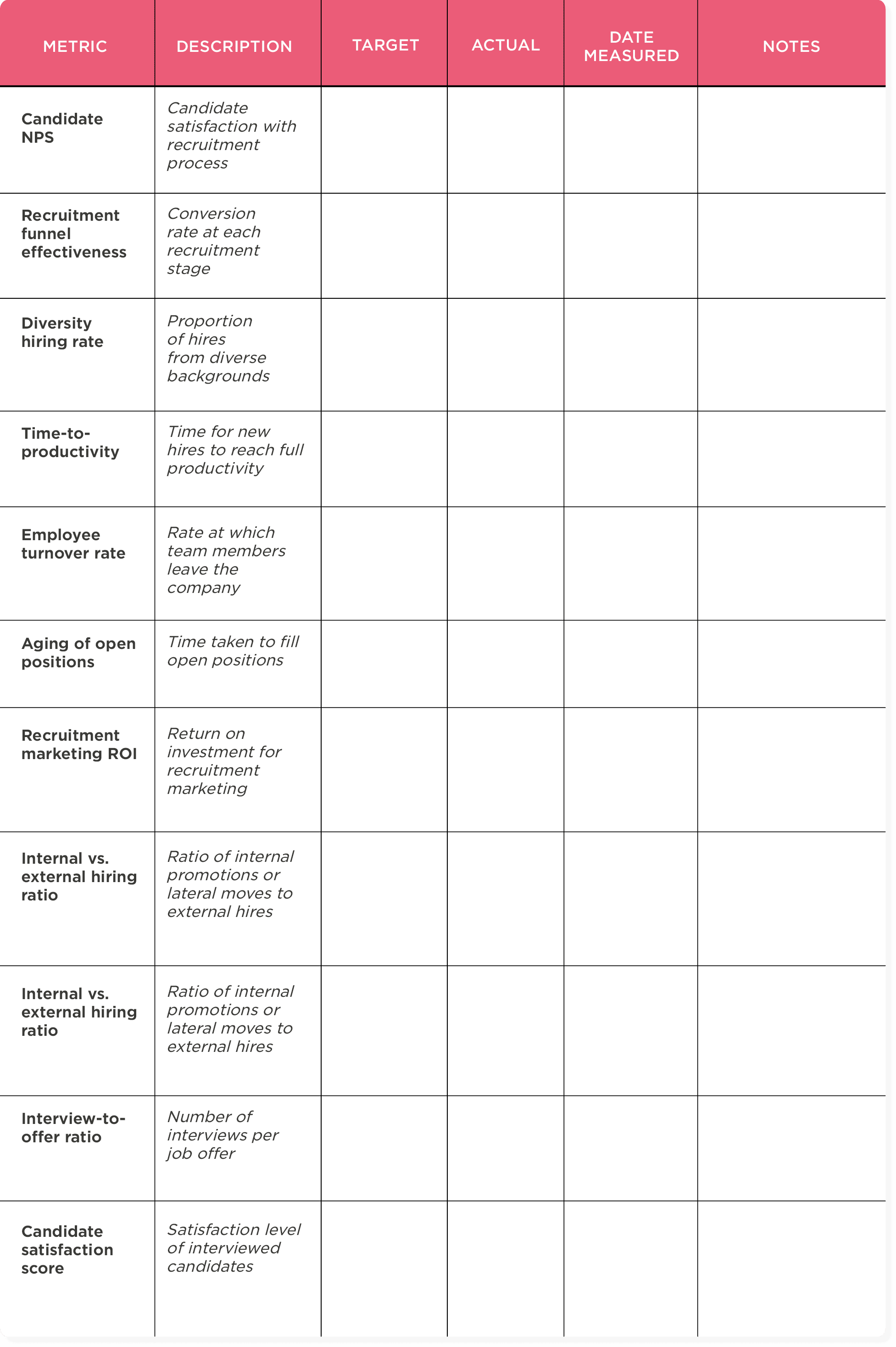The world of recruitment is one of fine margins.
With a fiercely competitive job market—stacked with both talent and companies wanting to snap up that talent—HR professionals need to be on their A-game to make the best hires possible for their organization.
That’s why recruiting metrics are a vitally important part of any organization and its recruitment strategies.
Read on as we delve into the details of recruiting metrics, explore their significance, and offer you a comprehensive recruiting metrics template for you to implement at your organization.
What are recruiting metrics?
Recruiting metrics are vital tools that HR teams can use to measure and improve their talent acquisition processes.
These metrics provide valuable insights and data that can help guide decision-making, improve strategies, and improve the overall hiring process, ultimately resulting in more successful hiring outcomes.

Why are recruiting metrics important?
Recruitment metrics aren’t just numbers—they’re important indicators of your organization’s hiring health and efficiency. And in a world where the cost of hiring is only going up, their significance extends far beyond just data collection and can offer multiple, tangible benefits.
Let’s take a look at some of the key points as to why talent acquisition metrics are so important:
- Strategic insights. HR metrics serve as a foundation for strategic, data-driven decision-making. By analyzing various different trends and outcomes, HR professionals can gain tangible insights into the efficacy of their recruitment strategies and better align them with organizational goals.
- Resource optimization. By identifying the more efficient and effective recruitment channels and techniques, recruitment metrics help organizations fully optimize their use of resources. HR professionals can better allocate budgets and ensure that time and effort are wisely invested in the most productive areas with this laser-focused approach, leading to a more efficient recruitment process.
- Performance tracking. By regularly monitoring your recruiting metrics, you can set clear benchmarks and track progress over time. This continuous evaluation helps you measure the success of your recruitment efforts and allows you to put any necessary changes in place to improve the hiring process over time.
<<Download and print our free recruiting metrics template today to make the most of your HR data.>>
17 recruiting metrics to track
Metric 1: Time-to-hire and time-to-fill
The time-to-hire and time-to-fill metrics track how efficient and effective your hiring process is. Specifically, time-to-fill measures how long it takes to fill and close a job listing from the time it’s opened. Time-to-hire measures the time a candidate takes to accept the job offer from the moment they enter your recruitment pipeline. These are important metrics to measure as they help you understand how effective your recruiting is and what inefficiencies you may have in the process.
Metric 2: Hire rate
Your hire rate is the percentage of candidates that receive and accept an offer. This metric helps provide insight into how effective your screening and interviewing process is. A low hire rate might highlight a need to reassess your job descriptions or screening criteria.
Metric 3: Cost per hire
Hiring can be an expensive process. By tracking your cost per hire, you can improve your budgeting and assess the cost-effectiveness of your recruitment process. Your cost per hire covers all expenses associated with hiring, including advertising, recruiter fees, and HR staff time.
Metric 4: Quality of hire
This metric measures the value your new hires bring to the organization. Measuring this involves performance appraisals, tracking retention rates, and counting how many pre-set goals are achieved throughout the initial employment period.
Metric 5: Source of hire
Source of hire identifies which channels of hiring, such as job boards, hiring websites, recruiters, or social media, are yielding the best results. This helps optimize your recruitment strategies and cut down on unnecessary costs.
Metric 6: Applicant drop-off rate
This metric measures the percentage of candidates who start the application process but then drop out along the way. By tracking your applicant drop-off rate, you can highlight potential issues within the application experience.
Metric 7: Offer acceptance rate
The offer acceptance rate is the ratio of accepted job offers to the total number of offers made. A high rate may indicate that the expectations of the organization align well with the candidates.
Metric 8: Candidate Net Promoter Score (NPS)
This assesses how satisfied your candidates are with your recruitment process, regardless of whether they’re hired or not. A high score indicates a positive experience, which is essential in a competitive job market.
Metric 9: Recruitment funnel effectiveness
Your recruitment funnel effectiveness analyzes the conversion rate at each stage of the recruitment process from application to hire. By pinpointing the stages where candidates drop out or get rejected, you can fine-tune your process.
Metric 10: Diversity hiring rate
Your diversity hiring rate tracks the effectiveness of your diversity-focused recruitment efforts. It does so by measuring the proportion of hires from diverse backgrounds.
Metric 11: Time-to-productivity
Getting new hires up to speed can be a lengthy process. By measuring the time it takes for a new team member to reach full productivity, you can gain valuable insight into the effectiveness of your onboarding process.
Metric 12: Employee turnover rate
This metric measures the rate at which team members leave your organization for any reason. While these reasons may have nothing to do with your company, the metric can give you insight into the long-term effectiveness of your hiring process.
Metric 13: Aging of open positions
By measuring how long open positions remain unfilled, you can get real insight into how difficult certain roles are to fill as well as the effectiveness of your recruitment drives.
Metric 14: Recruitment marketing ROI
Hiring effectively can result in a positive ROI for your organization’s recruitment process. By evaluating the return on your marketing efforts for open positions, you can understand the financial efficiency of your various strategies.
Metric 15: Internal vs. external hiring ratio
Filling vacancies doesn’t necessarily mean you have to source candidates from the outside world. This ratio compares the number of internal promotions or lateral moves to external hires, offering insights into the effectiveness of internal mobility and talent development.
Metric 16: Interview-to-offer ratio
This is the number of interviews conducted per job offer made. This helps you figure out the efficiency of your screening and interview process.
Metric 17: Candidate satisfaction score
Similar to NPS, this metric gives you insight into the satisfaction level of the candidates you’ve interviewed—giving you feedback on the interview process and how candidates feel they’ve been treated throughout.
Your recruiting metrics template
Using the key metrics listed above, we’ve created a free downloadable recruiting metrics template for you to use and tweak to fit your organization.
This template can be rewritten to accommodate your organization’s personal hiring metrics or used with the 17 metrics we’ve highlighted.
<<Download and print our free recruiting metrics template today to make the most of your HR data.>>
How to measure recruiting metrics benchmarks
Measuring your recruiting metrics benchmarks is a key part of fully utilizing the data you gather. To accurately measure these benchmarks, you’ll need to follow these steps:
- Identify relevant metrics. Start by deciding which metrics are most relevant to you, your team, and your organization’s goals and recruitment strategies. Different organizations will value different metrics, so there aren’t any hard and fast rules as to which recruitment metrics you should track.
- Gather your data. Collect data for each of the metrics you want to track. This can involve pulling data from your HR system, or manually compiling data if you don’t have a system in place.
- Analyze historical data. When looking at the present, it’s important to also look at the past. Analyze your historical recruitment data to establish some internal benchmarks. Look for things such as trends over time, as well as any noticeable improvements or declines.
- Compare against industry standards. Recruitment metrics benchmarks will vary depending on the industry. Research your industry standards by looking at published reports, attending HR seminars, or joining professional HR networks.
- Use HR technology for data analysis. Utilize HR analytics tools to get a better and deeper understanding of your data. These tools can help reveal insights that may not initially be clear.
- Set realistic goals. Once you’ve analyzed your data, set realistic and achievable goals for improvement. Make sure these goals align with your organizational objectives.
- Put strategies in place for improvement. If your metrics fall short of industry standards, it’s time to put a plan in place for improvement. This could involve rethinking your recruitment processes, investing in new HR tech, or improving your recruitment marketing.
- Review and adjust. Regularly review your metrics and adjust your strategies accordingly. The goal is to create a dynamic process that evolves alongside your organizational needs as well as the ever-shifting job market.
Recommended For Further Reading
Measuring and tracking recruiting metrics with HR technology
In the digital age, HR technology plays a key role in measuring and tracking recruiting metrics. Integrated systems such as applicant tracking systems (ATSs), HR dashboards, and analytics tools give you access to a wealth of information at a moment’s notice.
These systems help to streamline the process of collecting and analyzing recruitment data, making it far easier to identify things such as trends, bottlenecks, and areas for improvement.
Here’s more information on three key ways HR tech can help with recruiting metrics:
- ATSs. These systems are essential for managing the recruitment process from start to finish. They can track metrics such as time-to-fill, source of hire, and applicant drop-off rate.
- HR dashboards. Dashboards allow HR professionals to get a visual representation of key metrics, making data easier to digest and simpler to share with teams or stakeholders.
- Analytics tools. Advanced analytics tools can help you to dive deeper into your data. They provide you with key insights into areas such as candidate engagement, effectiveness of recruitment channels, and more.
Keeping track of your recruitment strategies
Recruitment metrics are where strategy meets science. In a world of fine margins, these metrics can give you the edge in a competitive sphere—empowering you to make data-driven decisions; elevate your hiring process; and continually learn, adapt, and evolve along the way.
<<Download and print our free recruiting metrics template today and make the most of your HR data.>>


